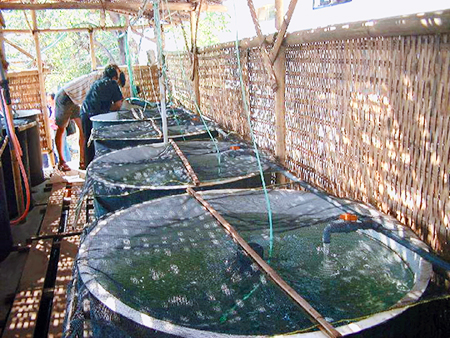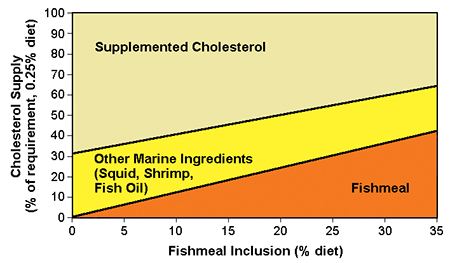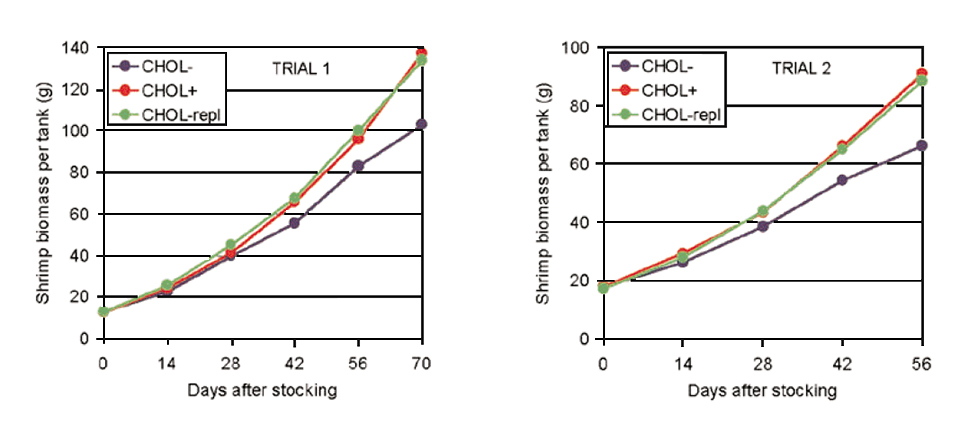Specialty concentrate enhances digestion and absorption of endogenous cholesterol in shrimp feed ingredients

Penaeid shrimp are unable to bio-synthesize cholesterol, which is widely accepted as an essential nutrient for these crustaceans. It is a key constituent of cell membranes and a precursor for steroid and moulting hormones.
Increased demand for cholesterol, combined with its relatively high cost and variable supply present a challenge for the shrimp feed industry. However, progress has been made in the development of cost-effective alternatives to purified cholesterol.
In laboratory trials with Penaeus monodon, the authors formulated a specialty concentrate that enhances digestion and absorption of endogenous cholesterol in shrimp feed ingredients and reduces the need to supplement feed with purified cholesterol.
Sources and availability
Meals and oils from marine invertebrates like squid, shrimp, clams, crabs and mussels are good sources of cholesterol. However, fishmeal is often the major cholesterol source in practical feed formulations for shrimp.
Feed-grade cholesterol is also derived from wool grease, a byproduct collected in the washing of sheep wool. The cost and availability of cholesterol fluctuated during the past decade, due to large variations in the market for wool grease (lanolin). Diminishing sheep stocks and increasing competition for lanolin derivatives (e.g., steroids) may become serious concerns for formulators of shrimp feeds in the future.

Tacon and Forster (2001) foresaw global aquafeed requirements for fishmeal to grow from 15 million metric tons in 2000 to 27 million MT by 2010. This will result in an increased demand for – and possible shortage of – marine raw materials.
Although animal byproducts offer interesting nutritional alternatives as protein sources for penaeid shrimp, their use is not accepted by European consumers and legislators. Therefore, the need for additional supplementation of cholesterol in shrimp feeds is likely to increase, due to the rising pressure on fishmeal as a protein source in shrimp feeds.
Assuming a minimum dietary level of 0.25 percent cholesterol, fishmeal at 35 percent inclusion in shrimp diets can provide around 50 percent of the requirement (Fig. 1). The addition of typical levels of shrimp and squid meal usually supplies another 20 to 25 percent. Thus, supplementation of purified cholesterol at 0.10 to 0.15 percent of the diet is needed to fully cover the requirement, and represents a significant cost in shrimp formulations.
Feed preparation and ingredients
For the trials, practical diets were prepared by lab scale pelletizing (Table 1). Diets were formulated to satisfy documented nutritional requirements of P. monodon, except for cholesterol (Akiyama et al., 1992).
Coutteau, Feed formulation for experimental diets, Table 1
| Ingredient | CHOL- | CHOL+ | CHOL-repl |
|---|
Ingredient | CHOL- | CHOL+ | CHOL-repl |
|---|---|---|---|
| Standard fishmeal (70% CP/10 CF) | 33.7 | 33.7 | 33.7 |
| Shrimp head meal | 4.0 | 4.0 | |
| Defatted soybean flour | 26.4 | 26.4 | 26.4 |
| Wheat middlings | 8.5 | 8.5 | 8.5 |
| Pregelatinized wheat starch | 20.0 | 20.0 | 20.0 |
| Soybean oil | 1.0 | 1.0 | 1.0 |
| Sodium alginate | 2.0 | 2.0 | 2.0 |
| Shrimp premix* | 3.0 | 3.0 | 3.0 |
| Cholesterol (85% purity) | 0.18 | ||
| Cholesterol-replacing premix** | |||
| Wheat middlings (filler) | 1.5 | 1.32 | |
| Total | 100 | 100 | 100 |
| Proximate composition (% diet) | |||
| Crude protein | 40.3 | 39.3 | 39.5 |
| Crude fat after hydrolysis | 7.3 | 7.4 | 7.2 |
| Crude ash | 8.8 | 9.1 | 9.2 |
| Crude fiber | 2.9 | 3.1 | 3.0 |
| Moisture | 7.1 | 6.9 | 7.2 |
** Cholesterol-replacing concentrate providing a blend of nutrients that enhance absorption and utilization of dietary cholesterol.
Table 1. Feed formulation for experimental diets in trial 1 (% as fed).
Three feed formulations were compared:
- A control diet (CHOL-) with a background concentration of 0.10 percent cholesterol, but no cholesterol supplementation.
- A positive control diet (CHOL+) supplemented with 0.15 percent cholesterol to a total level of 0.25 percent cholesterol.
- A test diet (CHOL-repl) supplemented with cholesterol replacement.
To verify initial findings, a second batch of feeds was prepared following the same guidelines, but using different batches of raw materials. This resulted in slightly different proportions of fishmeal (35 percent) and defatted soybean meal (25 percent), and a higher background of cholesterol in the feeds. CHOL-, CHOL+, and CHOL-repl contained 0.15, 0.30, and 0.15 percent cholesterol, respectively. Dietary cholesterol analysis was performed using GL chromatography.
Culture trials
Two culture trials were conducted at the Brackishwater Aquaculture Development Center in Indonesia.
Tanks and water
The experimental setup consisted of nine cylindrical, 1-metric tons (MT), flat-bottom tanks. Seawater was prepared by pumping through a 1-μm GAF filter bag, and recirculated over a 1.6-MT coral biofilter.
Salinity was adjusted to 25 ppt by the addition of underground freshwater, and disinfection with 3 milligrams per liter hypo-chlorite powder for 24 hours. Mean water renewal over the whole culture period was 28 percent per day.
Shrimp of 0.3 to 0.4 grams were initially stocked at 20 shrimp per tank and acclimated for one week prior to the start of the trial. Water temperature (27.5±0.7 degrees-C), salinity, and other quality parameters remained within acceptable limits during tests.
Survival, growth, FCR
Average survival during the first trial was over 88 percent (Table 2). Overall shrimp growth up to 1.4 grams per week toward the end of the trial was excellent under the conditions of clear water culture in small tanks. Feed-conversion ratios of 3.1 to 3.9:1 were adequate for shrimp feeding in clear water tanks without natural food organisms.
Coutteau, Results after growing P. monodon 70 days on experimental feeds, Table 2
| Parameter | CHOL- | CHOL+ | CHOL-repl |
|---|
Parameter | CHOL- | CHOL+ | CHOL-repl |
|---|---|---|---|
| Survival (%) | 88.3 | 90.0 | 91.7 |
| Final individual weight (g) | 5.86b | 7.78a | 7.48a |
| Growth rate (%/day) | 3.15b | 3.57a | 3.48a |
| Final total biomass (g) | 103.2b | 137.3a | 133.8a |
| Feed-conversion ratio | 3.9b | 3.1a | 3.4a |
Cholesterol supplementation

Growth and feed conversion were significantly improved by the supplementation of 0.15 percent cholesterol. After 70 days of culture, harvested biomass was 33 percenthigher for the shrimp fed the diet supplemented with cholesterol (Fig. 2). This was not due to density differences, but solely to dietary components.
Cholesterol replacement
The cholesterol-replacing concentrate was as effective as purified cholesterol in improving growth and feed conversion for the negative control diet. After 70 days of culture, harvested biomass was 30 percent higher in the CHOL-repl treatment than the negative control.
Overall shrimp survival was lower in trial 2, with treatment averages ranging 77 to 85 percent. However, the trends in growth response observed in this independent trial – run with different shrimp and different batches of raw materials for feed preparation – generally matched those of the first trial.
Conclusion
These studies confirmed that the requirement for dietary cholesterol in P. monodon exceeds the endogenous background level typically provided by ingredients of marine origin in practical diets. The supplementation of 0.15 percent purified cholesterol or 1.5 percent of a cholesterol-replacing concentrate to a practical diet with a cholesterol level of 0.1 to 0.15 percent significantly improved growth and feed conversion in juvenile shrimp.
Note: Cited references are available from the first author.
(Editor’s Note: This article was originally published in the June 2002 print edition of the Global Aquaculture Advocate.)
Now that you've finished reading the article ...
… we hope you’ll consider supporting our mission to document the evolution of the global aquaculture industry and share our vast network of contributors’ expansive knowledge every week.
By becoming a Global Seafood Alliance member, you’re ensuring that all of the pre-competitive work we do through member benefits, resources and events can continue. Individual membership costs just $50 a year. GSA individual and corporate members receive complimentary access to a series of GOAL virtual events beginning in April. Join now.
Not a GSA member? Join us.
Authors
-
Peter Coutteau
INVE Aquaculture Nutrition
Oeverstraat 7
B-9200 Baasrode, Belgium -
Jef Peeters
INVE Asia Services, Ltd.
Amphur Pakkred, Nonthaburi, Thailand -
Abidin Nur
Brackishwater Aquaculture Development Center
Jepara, Central Java, Indonesia -
Endhay K. Kontara
Brackishwater Aquaculture Development Center
Jepara, Central Java, Indonesia
Related Posts

Aquafeeds
Animal byproducts can provide cholesterol for shrimp feed
Animal byproducts like blood meal, meat and bone meal and other rendered products are good sources of cholesterol for use in aquaculture feed.

Health & Welfare
Digestibility enhancer can offset cholesterol content in shrimp feed
Cholesterol is an essential nutrient for penaeid shrimp. Trials found that a digestibility enhancer based on natural emulsifiers was as effective as purified cholesterol in improving shrimp growth and feed conversion.

Intelligence
Facts about shrimp and cholesterol
Many people, including health-conscious consumers, are concerned about the cholesterol content of foods such as meat, eggs and dairy products. In the case of shrimp, the cholesterol story is different because a number of research studies have demonstrated that the high percentage of “good fats” in shrimp reduce the impact of cholesterol, and that a majority of people can eat shrimp as part of a balanced diet.

Aquafeeds
A look at phospholipids in aquafeeds
Phospholipids are the major constituents of cell membranes and are vital to the normal function of every cell and organ. The inclusion of phospholipids in aquafeeds ensures increased growth, better survival and stress resistance, and prevention of skeletal deformities of larval and juvenile stages of fish and shellfish species.


